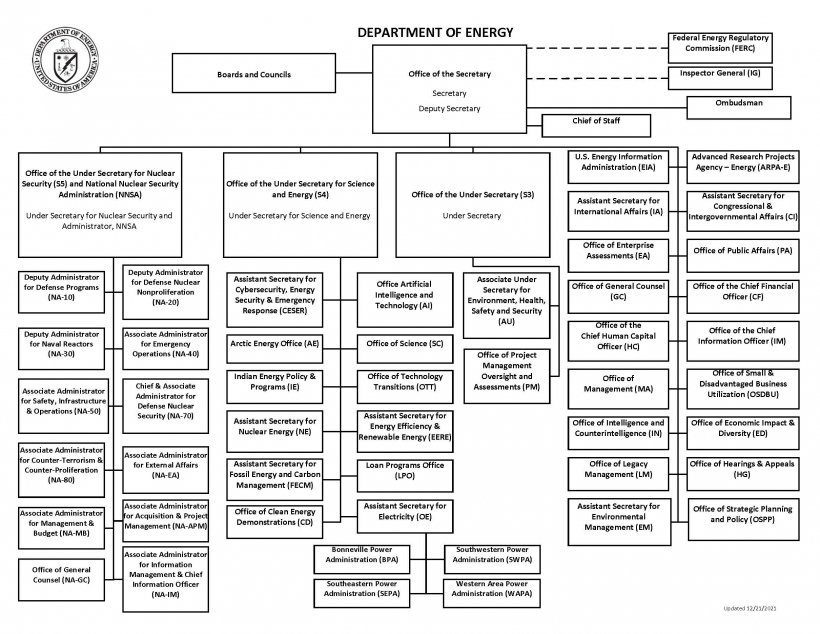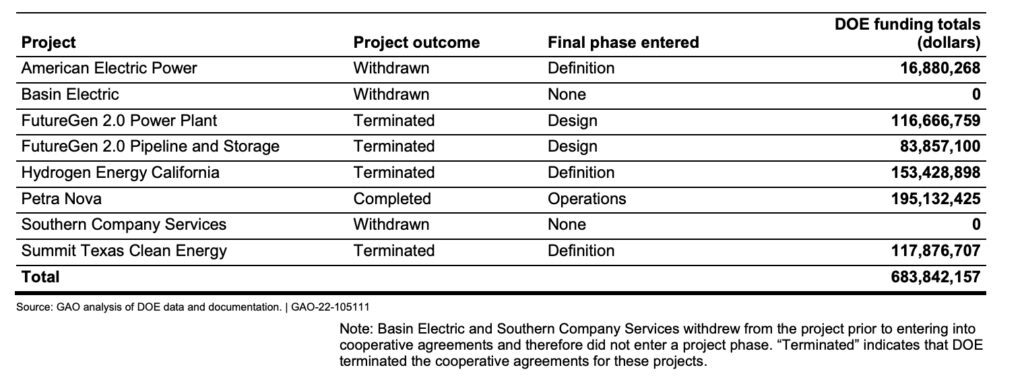Infrastructure Act Power Technology Demonstrations DOE's Newly Dedicated Office Will Manage
As required by the Bipartisan Infrastructure Act, the U.S. Department of Energy (DOE) on Dec. 21 launched a new office—the Office of Clean Energy Demonstrations—to “supercharge” its work to demonstrate hydrogen, carbon capture, energy storage, and advanced nuclear technologies.
The new office will leverage $21.5 billion of the combined $62 billion allocated to the DOE by the $1 trillion Infrastructure Act, which President Biden signed into law on Nov. 15. As established by the law, the new office will “conduct administrative and project management responsibilities” for a lengthy list of demonstrations that will further the administration’s climate goals. Along with conducting proposal evaluations and independent oversight of project execution, the office will also work to ensure a “balanced portfolio of investments in covered projects,” the law says.
Founding of the new office “represents a new chapter that builds on DOE’s long-standing position as the premier international driver for clean energy research and development, expanding DOE’s scope to fill a critical innovation gap on the path to net-zero emissions by 2050,” the DOE said on Tuesday.“Demonstration projects prove the effectiveness of innovative technologies in real-world conditions at scale in order to pave the way towards widespread adoption and deployment,” it added. Demonstrations under its purview “will fund projects totaling hundreds of millions or multiple billions of dollars in scale and will unlock massive follow-on investment from the private sector to deploy these technologies, delivering clean energy and creating good-paying jobs in communities across the country,” it said.

Which Demonstrations Will the Office of Clean Energy Demonstrations Pursue?
Many “clean energy” demonstrations outlined in the Infrastructure Act are established by the “Energy Act of 2020,” a bill that was tacked onto the giant December 2020–enacted Consolidated Appropriations Act, 2021. The Energy Act, notably, combined bipartisan provisions from the Senate’s S. 2657 (the American Energy Innovation Act) and the House’s H.R. 4447 (the Clean Energy Jobs and Innovation Act), as well as parts of 37 Senate bills. Some projects also leverage authorization from the Energy Policy Act of 2005, which was landmark legislation that markedly defined the trajectory of power sector regulation and technology development over the last decade.
The DOE’s new Office of Clean Energy Demonstrations will focus on a select set of projects outlined in the Infrastructure Act. The following is a list of most large-scale demonstrations outlined in the Infrastructure Act, including those that likely won’t fall under the new office’s jurisdiction.
The Energy Storage Demonstration Pilot Grant Program. The 2021 Infrastructure Act provides a total of $355 million, including $88.7 million every year for fiscal years 2022 through 2025, for energy storage demonstrations. The 2020 Energy Act requires the DOE to identify and begin carrying out three energy storage system demonstrations by September 2023, including at least one demonstration that will support advanced energy storage technologies.
Long-Duration Demonstration Initiative and Joint Program. Separately, the Infrastructure Act provides $150 million through 2025 (at $37.5 million a year) to demonstrate “promising” long-duration energy storage technologies at different scales. The 2020 Energy Act requires the DOE to collaborate with the Department of Defense on a “joint program.”
Advanced Reactor Demonstration Program (ARDP). While the ARDP is currently spearheaded by the DOE’s Office of Nuclear Energy, it is unclear if the Office of Clean Energy Demonstrations will take over project management and oversight of demonstrations already awarded under this program. The Infrastructure Act allocated $2.5 billion for the ARDP as authorized under section 959A of the Energy Policy Act of 2005, funding that falls under the Office of Clean Energy Demonstrations.
So far under the ARDP, the Natrium consortium comprising TerraPower and GE Hitachi, among others, is set to demonstrate a commercial-scale 500-MW project that will pair a 345-MW sodium-cooled fast reactor with a molten salt-based energy storage system at a coal plant in Wyoming. Rockville, Maryland–based X-energy, which also won first-round funding under the first ARDP pathway in a tough competition for the federal funding opportunity, has said it will use the funding to deliver a commercial four-unit power plant based on its Xe-100 reactor design, an 80-MWe/200-MWth pebble-bed high-temperature gas reactor, which can be scaled as a four-pack to 320 MWe, at a site in Washington state in partnership with public-power utility Energy Northwest. X-energy, notably, will also leverage the ARDP award to deliver a commercial-scale fuel fabrication facility for its proprietary TRISO-X TRi-structural ISOtropic particle fuel (TRISO) technology.
Carbon Capture Large-scale Pilot Projects. Under the Infrastructure Act, the Office of Clean Energy Demonstrations will oversee investments of $937 million through 2025 to carry out large-scale carbon capture pilot projects, authorized under section 962(b)(2)(B) of the 2005 Energy Policy Act. The Infrastructure Act also provides for another $2.5 billion for the Carbon Capture Demonstration Projects Program.
Shedding some light on how the funds may be spent, the DOE’s Office of Fossil Energy—which is now named the Office of Fossil Energy and Carbon Management (FECM) to reflect the administration’s low-carbon priorities—in a Dec. 1 webinar said its priority areas of technology work include “point-source” carbon capture, hydrogen, methane emissions reduction, critical mineral production, and carbon dioxide removal. Dr. Emily Grubert, deputy assistant secretary for the Office of Carbon Management, said the DOE will deploy about $10 billion in new direct carbon management funding over the next five years, including through regional direct-air capture (DAC) “hubs,” and a DAC technology prize competition. Among the FECM’s engineered stack capture initiatives funded by the Infrastructure Act are carbon capture demonstrations and large pilots, which, as mentioned, will get a combined $3.5 billion under the Infrastructure Act. The DOE also plans to spearhead carbon storage validation and testing, for which it will get $2.5 billion, she said.
Any DOE carbon capture demonstrations may however be conducted under extraordinary scrutiny. On Dec. 17, the Government Accountability Office issued a scathing report that found that while the DOE sank $1.1 billion in carbon capture and storage (CCS) demonstration investments since 2009, only one of eight coal power projects—(Petra Nova, POWER’s 2017 Plant of the Year, and a project that has now been mothballed)—and two of three industrial projects achieved commercial operation. The GAO said the DOE’s investments were ridden with high-risk selection and negotiation processes. It also said that the DOE did not adhere to cost controls to limit its financial exposure on funding agreements for coal projects that it ultimately terminated. “As a result, the agency spent nearly $472 million on the definition and design of four unbuilt facilities—almost $300 million more than planned for those project phases,” it said.

Clean Energy Demonstration Program on Current and Former Mine Land. The Infrastructure Act allocates $500 million through 2026 under the Office of Clean Energy Demonstrations for a new program it establishes that will demonstrate “clean energy” on mining or reclaimed mining land. The provision limits “clean energy” sources under this provision to solar, microgrid, geothermal, direct air capture, abated fossil electricity (or fossil power equipped with CCS), and energy storage, including pumped hydro and compressed air storage.
Regional Clean Hydrogen Hubs. The Infrastructure Act also provides a stunning $8 billion through 2026 to the Office of Clean Energy Demonstrations to establish four potential regional deployments catering to hydrogen infrastructure, as authorized under section 813 of the Energy Policy Act of 2005. The DOE envisions these “hubs” will deliver, store, and enable end-use of hydrogen produced with zero-carbon sources across multiple applications or sectors.
Notably, while the DOE on Oct. 8 announced its intent to issue a funding opportunity to analyze the potential for these hubs, it canceled that measure on Dec. 1 given the Infrastructure Act’s requirements that the agency solicits proposals for regional clean hydrogen hubs “not later than 180 days after the date of the Act’s enactment.”
The Infrastructure Act requires the agency to ensure that the four hubs will demonstrate production of clean hydrogen from varying feedstocks, including fossil fuels, renewables, and nuclear. At least one regional clean hydrogen hub will meanwhile demonstrate the end-use of clean hydrogen in the electric power generation sector, and others will demonstrate end-use in the industrial, residential and commercial heating sectors, and transportation sectors.
Meanwhile, it is unclear whether the Office of Clean Energy Demonstrations will spearhead the Infrastructure Act’s required demonstration of projects to validate the cost, efficiency, durability, and feasibility of electrolyzers. The Infrastructure Act says the goal of the Clean Hydrogen Electrolysis Program is to reduce the cost of hydrogen produced using electrolyzers to less than $2/kilogram by 2026.
Program Upgrading Our Electric Grid and Ensuring Reliability and Resiliency. Under the Infrastructure Act, the Office of Clean Energy Demonstrations will invest a hefty $5 billion through 2026 to establish a program to provide—on a competitive basis—federal assistance to demonstrate “innovative approaches to transmission, storage, and distribution infrastructure to harden and enhance resilience, and reliability.” This includes $1 billion for activities for energy improvement in rural and remote areas. The program will entail coordination and collaboration with power sector owners and operators to demonstrate regional grid resilience.
Notably, however, the program will also require the DOE, the Secretary of Homeland Security, the Federal Energy Regulatory Commission, and the nation’s electric reliability organization—the North American Electric Reliability Corp.—to develop “common analytical frameworks, tools, metrics, and data to assess the resilience, reliability, safety, and security of energy infrastructure in the United States.” One initiative will include developing and storing an inventory of “easily transported high-voltage recovery transformers and other required equipment.” The DOE is expected to submit a report to Congress describing results of a required assessment by May 2023.
Demonstration of Electric Vehicle Battery Second-Life Applications for Grid-Services. While not listed within the Office of Clean Energy Demonstrations’ allocations, the Infrastructure Act calls on the Energy Secretary to “enter into an agreement” on a project to demonstrate second-life applications of electric vehicle (EV) batteries as aggregated energy storage installations to provide ancillary services to the grid. The law instructs the DOE to prioritize projects in which applications are “paired with one or more facilities that could particularly benefit from increased resiliency and lower energy costs, such as a multi-family affordable housing facility, a senior care facility, and a community health center.”
Rare Earth Elements Demonstration Facility. While this demonstration may also be outside the Office of Clean Energy Demonstrations’ purview, the Infrastructure Act requires the DOE to fund a rare earth demonstration facility to “provide environmental benefits through the use of feedstock derived from acid mine drainage, mine waste, or other deleterious material. The facility should also separate mixed rare earth oxides into pure oxides of each rare earth element and refine rare earth oxides into rare earth metals. The law allocates $140 million in 2022 for the facility.
On Dec. 9, notably, General Atomics Electromagnetic Systems (GA-EMS), a San Diego–based firm that manufactures electromagnetic and power generation systems, announced it had finalized negotiations with the DOE’s Advanced Manufacturing Office for facility design and engineering in preparation for the construction and operation of a Rare Earth Element (REE) Separation and Processing Demonstration Plant. GA-EMS said it will team with GA Europe’s Umwelt-und-Ingenieurtechnik GmbH (UIT), Rare Element Resources Ltd. (RER), and LNV, an Ardurra Group company, to begin a 40-month project to design, build, and operate the REE separation and processing demonstration facility in Wyoming.
“Once completed, the demonstration plant will enable the separation and purification of rare earth oxides derived from ore removed from RER’s Bear Lodge deposit in Wyoming,” GA-EMS told POWER. “The project’s primary goal is to demonstrate REE separation and processing at a scale sufficient to provide data and metrics predictive of cost and performance for a follow-on commercial-scale separation and processing facility.”
—Sonal Patel is a POWER senior associate editor (@sonalcpatel, @POWERmagazine).